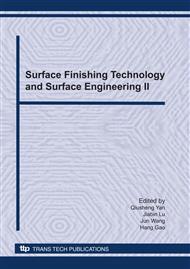p.134
p.139
p.143
p.149
p.154
p.159
p.164
p.170
p.174
Effect of Grinding Process Parameters on Surface Layer Residual Stress
Abstract:
Grinding induces tensile residual stresses, which can play an adverse role on the fatigue and wear resistance of the component. In this paper, a calculation model of residual stresses induced by a surface grinding process on a ultrahigh-strength steel workpiece (Aermet100) is presented, which includes the transient heat conduction equation、a thermal elastic-plastic constitutive equation and the Von Mises yield condition. The model giving the energy conducted as heat in the workpiece as a function of the grinding wheel speed, the workpiece speed, and the cutting depth is proposed. It is shown that, for such grinding conditions, the simulation leads to tensile residual stresses which increase with the wheel speed and cutting depths increase. The paper offers an insight into the mechanism understanding of thermal residual stresses induced by surface grinding.
Info:
Periodical:
Pages:
154-158
Citation:
Online since:
October 2010
Authors:
Keywords:
Price:
Сopyright:
© 2010 Trans Tech Publications Ltd. All Rights Reserved
Share:
Citation:


